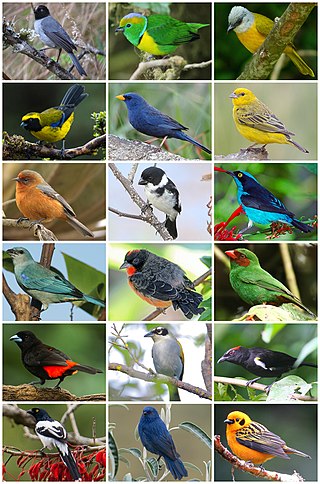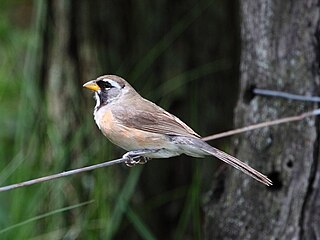
The tanagers comprise the bird family Thraupidae, in the order Passeriformes. The family has a Neotropical distribution and is the second-largest family of birds. It represents about 4% of all avian species and 12% of the Neotropical birds.

The red-crowned ant tanager is a medium-sized passerine bird from tropical America. It is the only species now placed in the genus Habia. This species was long placed with the tanagers (Thraupidae), but it is actually closer to the cardinals (Cardinalidae).

Saltator is a genus of passerine birds in the tanager family Thraupidae that are found in Central and South America. They have thick bills, relatively long tails and strong legs and feet. Before the introduction of molecular genetic methods in the 21st century these species were placed in the cardinal family Cardinalidae.

Haplospiza is a small genus of birds in the tanager family Thraupidae. Formerly classified in the bunting and American sparrow family Emberizidae, more recent studies have shown it to belong in the Thraupidae. Its two members breed in subtropical or tropical moist forest in Central and South America. They are often associated with bamboo.

Tachyphonus is a genus of birds in the tanager family Thraupidae.

The black-goggled tanager is a species of bird in the family Thraupidae. It is the only member of the genus Trichothraupis. It is found at low levels in forest and woodland in a large part of eastern and southern Brazil, eastern Paraguay, and far north-eastern Argentina, with a disjunct population along the East Andean slope in Peru, Bolivia, and far north-western Argentina. While generally common and widespread, and consequently considered to be of least concern by BirdLife International and IUCN, the population associated with the Andes is relatively local and uncommon.

Idiopsar is a genus of Neotropical seed-eating birds in the tanager family Thraupidae.

The Inca finches form the genus Incaspiza, of finch-like birds in the tanager family Thraupidae. They were traditionally placed in the family Emberizidae, but molecular phylogenetic studies have shown that they belong in Thraupidae instead. Both their scientific and common name refer to the Incan civilization.

The yellow-shouldered grosbeak is a species of bird in the tanager family Thraupidae. It is the only member of its genus Parkerthraustes. It is found in Bolivia, Brazil, Colombia, Ecuador, and Peru. Its natural habitat is subtropical or tropical moist lowland forests.

Camarhynchus is a genus of birds in the tanager family Thraupidae. All species of Camarhynchus are endemic to the Galápagos Islands, and together with related genera, they are collectively known as Darwin's finches. Formerly classified in the bunting and American sparrow family Emberizidae, more recent molecular genetic studies have shown it to belong in the tanager family.

The diuca finch is a species of bird in the tanager family Thraupidae. It is the only member of the genus Diuca. It is found in Argentina, Bolivia, Brazil, Chile, and Uruguay. Its natural habitats are subtropical or tropical dry shrubland, subtropical or tropical high-altitude shrubland, and heavily degraded former forest.

The long-tailed reed finch is a species of South American bird in the tanager family Thraupidae. It is the only member of its genus Donacospiza.

The grey-headed tanager is a widely distributed species of small Neotropical bird in the tanager family Thraupidae. It is the only member of the genus Eucometis.

Geospiza is a genus of bird in the tanager family Thraupidae. All species in the genus are endemic to the Galápagos Islands. Together with related genera, they are collectively known as Darwin's finches. Although in the past, they were classified in the bunting and American sparrow family Emberizidae, more recent studies have shown they belong in the tanager family.

Saltatricula is a genus of South American seed-eating birds in the tanager family Thraupidae.

Loxigilla is a genus of passerine birds in the tanager family Thraupidae. The two species are both endemic to the Lesser Antilles.

The yellow-shouldered grassquit is a species of bird in the tanager family Thraupidae that is endemic to Jamaica. It is the only member of the genus Loxipasser. Its natural habitats are subtropical or tropical moist lowland forest, subtropical or tropical moist montane forest, and heavily degraded former forest.

Melanospiza is a genus of Neotropical birds in the tanager family Thraupidae.

The warbler-finches are a genus Certhidea of birds in the tanager family Thraupidae that are endemic to the Galápagos Islands. Together with related genera, they are collectively known as Darwin's finches.

Asemospiza is a genus of South American birds in the tanager family Thraupidae.






















